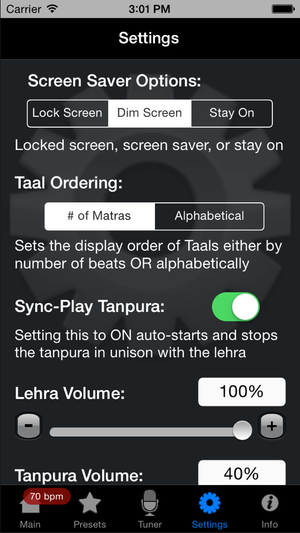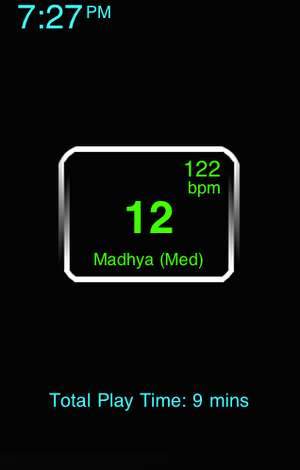Tabla solos are accompanied by cyclic melodies called lehra (also sometimes called lahara or nagma), which serve as an aural reference to the taal (rhythmic cycle) for both the performer and for the audience. Practicing to a lehra is an important part of a tabla player's practice routine, and the best tool available for this, other than hiring a sarangi or harmonium player to accompany one's practice, is the iLehra app for iOS by Prasad Upasani. The app is available in the Apple App Store, and costs $19.99 USD. The app is definitely not cheap, but when one compares with other professional music tools, it is in fact very reasonable for what is offered. And, you definitely do get what you pay for (and more...). (For a free lehra app, please see this blog post.)
The app provides lehras in numerous common and uncommon taals, and with multiple ragas to choose from within each taal. The interface is straightforward and easy to use, with most of the controls easily accessible on the main screen. There is also a tanpura, which sounds great; much better than those electronic tanpura boxes. The tanpura automatically adjusts to Ma or Pa tuning, as appropriate for the selected raga. There are even some ragas where the tanpura will switch to Ni tuning, which is a nice touch.

Basic operation is simple. Right at the top, is the pitch selector. Clicking on the up or down arrows moves through the pitches by semi-tone, ie: C, C#, D, D#, etc. Directly underneath is the fine-tuner for microtonal adjustment, if needed. When this option is used, the resulting frequency will be shown next to the note name. Another way to select the pitch is by simply clicking on the letter; then a pull-down menu appears.
Next, one selects the taal, and then the desired raag. There is also a choice of instrument. The samples used for playback are pretty basic, but do the job. The santoor probably sounds the most realistic, but I personally use the harmonium sample the most. What I would really love to have is a sarangi option!
Underneath this, we see the play buttons for tanpura and lehra, providing the ability to start and stop the tanpura and lehra playback separately. The tanpura can also be configured to auto-start when the lehra button is pressed (Settings --> Sync-Play Tanpura). The settings screen also allows for the volume levels of the tanpura and lehra to be set.
Between the two play buttons, we can see the current tempo, matra (beat) number, and tali/khali (claps/waves). The tempo can be selected either by tapping in the tempo box (a feature that most people I spoke to were completely unaware of!), or by using the tempo controls below. There is a slider, which moves quickly through the range of available tempos; the - and the +, which move the tempo up or down by one bpm at a time; and underneath, options to halve the tempo, subtract 5 bpm, add 5 bpm, or double the tempo. The available range is 15 bpm up to 500 bpm (up from 400 bpm in previous releases). These tempos do exist in North Indian classical music!
There are some additional features, such as a built-in tuner (but really, we should tune with our ears!), and the ability to add a metronome click on the beat, or in subdivisions of 2, 3 or 4.

While playing, the screen saver shows the time, beat count, tempo, and the amount of time that the app has been playing; a great way to keep track of how long you've actually been practicing.

What's great is that the app is constantly being developed, and is updated often with new melodies. For a tabla player, iLehra is all you need, but if you are a singer or instrumentalist, then you should definitely have a look at iTablaPro ($24.99), which includes both tabla and tanpura accompaniment, along with a number of other bells and whistles. It should be noted that iTablaPro includes the iTanpura app, which is also available separately. I use it when I want to create a tanpura with more complex tuning, as the app allows for two tanpuras to run simultaneously, and each can be tuned differently.
Know of any other Indian music apps that I should write about? Contact me!
The app provides lehras in numerous common and uncommon taals, and with multiple ragas to choose from within each taal. The interface is straightforward and easy to use, with most of the controls easily accessible on the main screen. There is also a tanpura, which sounds great; much better than those electronic tanpura boxes. The tanpura automatically adjusts to Ma or Pa tuning, as appropriate for the selected raga. There are even some ragas where the tanpura will switch to Ni tuning, which is a nice touch.

Basic operation is simple. Right at the top, is the pitch selector. Clicking on the up or down arrows moves through the pitches by semi-tone, ie: C, C#, D, D#, etc. Directly underneath is the fine-tuner for microtonal adjustment, if needed. When this option is used, the resulting frequency will be shown next to the note name. Another way to select the pitch is by simply clicking on the letter; then a pull-down menu appears.
Next, one selects the taal, and then the desired raag. There is also a choice of instrument. The samples used for playback are pretty basic, but do the job. The santoor probably sounds the most realistic, but I personally use the harmonium sample the most. What I would really love to have is a sarangi option!
Underneath this, we see the play buttons for tanpura and lehra, providing the ability to start and stop the tanpura and lehra playback separately. The tanpura can also be configured to auto-start when the lehra button is pressed (Settings --> Sync-Play Tanpura). The settings screen also allows for the volume levels of the tanpura and lehra to be set.
Between the two play buttons, we can see the current tempo, matra (beat) number, and tali/khali (claps/waves). The tempo can be selected either by tapping in the tempo box (a feature that most people I spoke to were completely unaware of!), or by using the tempo controls below. There is a slider, which moves quickly through the range of available tempos; the - and the +, which move the tempo up or down by one bpm at a time; and underneath, options to halve the tempo, subtract 5 bpm, add 5 bpm, or double the tempo. The available range is 15 bpm up to 500 bpm (up from 400 bpm in previous releases). These tempos do exist in North Indian classical music!
There are some additional features, such as a built-in tuner (but really, we should tune with our ears!), and the ability to add a metronome click on the beat, or in subdivisions of 2, 3 or 4.

While playing, the screen saver shows the time, beat count, tempo, and the amount of time that the app has been playing; a great way to keep track of how long you've actually been practicing.

What's great is that the app is constantly being developed, and is updated often with new melodies. For a tabla player, iLehra is all you need, but if you are a singer or instrumentalist, then you should definitely have a look at iTablaPro ($24.99), which includes both tabla and tanpura accompaniment, along with a number of other bells and whistles. It should be noted that iTablaPro includes the iTanpura app, which is also available separately. I use it when I want to create a tanpura with more complex tuning, as the app allows for two tanpuras to run simultaneously, and each can be tuned differently.
Know of any other Indian music apps that I should write about? Contact me!
